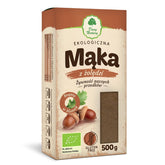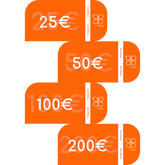Peanut butter – types, properties, uses in the kitchen
Contents:
Peanut butter, primarily associated with the favorite delicacy of Americans (and also the Dutch), is also becoming increasingly popular in Poland. This is due, among other things, to the search for alternatives to animal products and the interest in a healthy, wholesome, plant-based diet. Peanut butter is made from nuts—mostly peanuts, but not exclusively—that are roasted at over 200°C, then ground and cooled. A jar of peanut butter typically contains at least 90% nuts. What characterizes this popular spread, what types are there, and how can we use it in the kitchen?
Properties of peanut butter
Peanuts, also known as groundnuts or peanuts, are a valuable source of nutrients that positively impact the proper functioning of our brain and nervous system. They provide, among other things:
- oleic acids,
- Vitamins B, E,
- vegetable proteins,
- fiber ,
- Potassium and magnesium.
Because it's a plant-based product, it's especially recommended for vegetarian and vegan diets. It provides people who avoid animal products with a high amount of protein and magnesium. The nutrients contained in nuts and peanut butter have a positive effect on the nervous system and support memory and concentration. Nuts also have anti-inflammatory and blood pressure-regulating effects.
Types of peanut butter
Although until recently, the first thing that came to mind when we thought of peanut butter was peanut butter, today the selection is much wider. We can try almond, pistachio, or hazelnut spreads:
- Hazelnut butter – Contains high levels of potassium, phosphorus, magnesium, and calcium, as well as the fat-soluble vitamins A, E, K, and B vitamins. It also supports bone health and reduces the risk of osteoporosis.
- Pistachio butter – Pistachios provide less energy and fat than other nuts. However, they are a rich source of iron, potassium, copper, and magnesium, vitamins B6, E, and K, thiamin, phytosterols, lutein, and zeaxanthin. They have antioxidant properties, have a positive effect on heart function, and the lutein and zeaxanthin they contain support vision.
- Almond butter is an excellent source of vitamins A, C, and E, as well as B vitamins. It also contains high levels of magnesium, iron, copper, and zinc. It has a positive effect on the proper functioning of the brain, improving memory and concentration, as well as the function of the heart and the entire circulatory system.
The use of peanut butter in the kitchen
We primarily associate peanut butter with a delicious sandwich topping, but its uses are much broader. It's also a great ingredient for healthy breakfast, lunch, and dinner:
- Oatmeal with peanut butter for breakfast – Oatmeal prepared with milk (plant-based or animal-based, depending on your preference) or water, with the addition of your favorite ingredients. These can include apples, bananas, blueberries, raspberries, nuts and dried fruit, and select peanut butter. This breakfast is not only delicious, but also filling and packed with nutrients.
- A smoothie bowl is a bowl full of fruit with added peanut butter. To prepare this meal, simply combine a portion of natural yogurt with peanut butter and your favorite seasonal fruits, such as blueberries, raspberries, strawberries, or diced apples, bananas, and pears. Top with pumpkin or chia seeds. Top with maple syrup for a healthy dessert that satisfies our sweet tooth while providing valuable and healthy nutrients for our bodies.
- Chicken Breast in Peanut Butter Sauce – Place washed, dried, and diced chicken breast (about 500 g) in a bowl, add 3 tablespoons of soy sauce, half a teaspoon of pepper, and hot pepper, mix, and let stand for about half an hour. In a separate bowl, add a glass of chicken broth, lime juice, a few cloves of garlic, chopped chili, 2 tablespoons of runny honey , about 2 tablespoons of soy sauce, and half a glass of peanut butter. Fry the chicken breast in a heated pan for a few minutes, then add the mixed sauce and heat, stirring, until thickened. Serve the finished meat with noodles or rice.
Peanut butter, no matter which variety you choose, provides us with valuable nutrients. It's a source of vitamins and has beneficial effects on our bodies, especially on the nervous system and brain. You can eat it with fruit, add it to cereal, a sweet cocktail, or a savory sauce, use it as a sandwich spread, or make healthy homemade bars or power balls. Peanut butter should not be consumed by people with a nut allergy.
THE PUBLISHER'S CHOICE
Dried plums 1 kg BIOGO
- £6.08
- £6.08
- Unit price
- / per
Dried White Mulberries 500 g ORGANIC
- £5.06
- £5.06
- Unit price
- / per
Almonds 1 kg BIOGO
- £10.14
- £10.14
- Unit price
- / per
Cranberries sweetened with apple juice organic 1 kg BIOGO
- £14.19
- £14.19
- Unit price
- / per
Dried dates 1 kg BIOGO
- £3.65
- £3.65
- Unit price
- / per
Unpeeled buckwheat groats 1 kg BIOGO
- £2.44
- £2.44
- Unit price
- / per
Walnuts 800 g BIOGO
- £7.50
- £7.50
- Unit price
- / per
Peeled sunflower seeds 1 kg BIOGO
- £2.64
- £2.64
- Unit price
- / per
PULLED ORGANIC SUNFLOWER SEEDS 1 KG BIOGO
- £3.85
- £3.85
- Unit price
- / per












































































































































